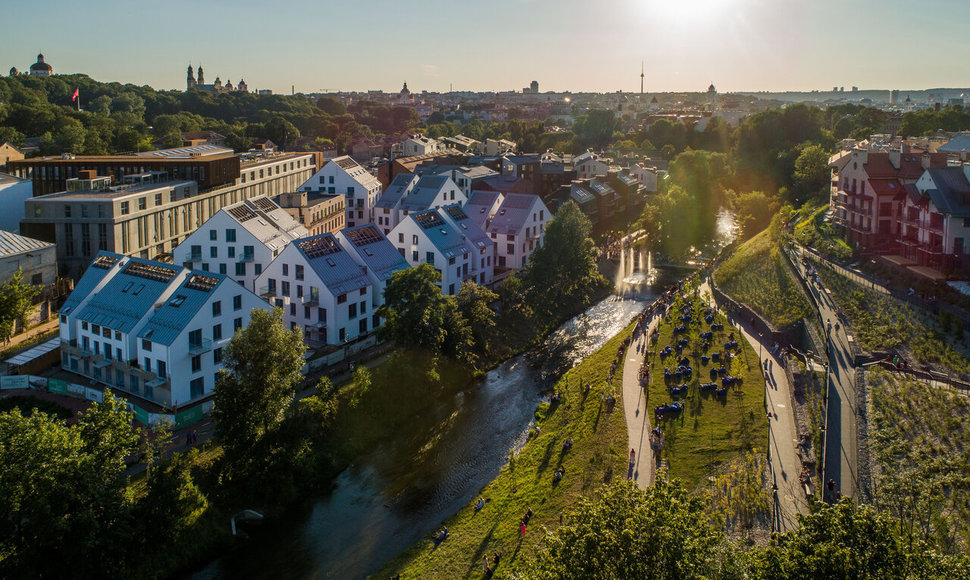The results of a study conducted by ‘Sustainable Urban Lab’, a branch of ‘Darnu Group’, one of the largest companies in Lithuania that creates spaces for life, work and leisure, revealed that the layout of the district is most enjoyed by the residents of Lazdynai (7.62 points out of 10), Žvėrynas (7.48), Naujamiestis (7.47) and Antakalnis (7.26), while Vilnius residents living in Viršuliškės (6.22), Grigiškės (6.35), Naujininkai (6.53) and Pašilaičiai (6.58) are the least satisfied with their residential area.
What factors have the greatest impact on people’s happiness index? Urbanist Martynas Marozas seems to know the answer.
Convenience is of the utmost importance
‘The most important thing for a person is not to feel forgotten in their area. There are districts in Vilnius that are constantly being tidied up, renewed, while other parts of the city remain on the side-lines. The most densely populated areas are often forgotten, while the least populated areas receive the largest investments. That should not be the case’, says Martynas Marozas.
The urbanist says that one of the most important factors determining well-being is a comfortably designed environment. From sidewalks adapted to different needs, to elevators in apartment buildings – we all want to move comfortably and have all the necessary services or entertainment around.
‘I am also talking about the integration of both seniors and the disabled, and about children’s playgrounds. When the sidewalks are lowered so that it is convenient to ride in a wheelchair, when there is no need to wait for a neighbour in the stairwell to help you carry things, but you can simply use the elevator, when the block is conveniently and well planned and you don’t have to walk in circles in order to even get inside your building – then living in a certain location becomes that much more pleasurable’, says Martynas Marozas.
According to survey data, when assessing the convenience of living in a certain district, Vilnius residents pay the greatest attention to the developed infrastructure and want the most popular places of the city to be easily accessible from their district. One in five residents of the capital gives priority to communication and the desire to avoid traffic jams, and would also like to live in a quiet area in a good, convenient place where they would not have to worry about parking their cars.
‘Darnu Group’ experts also notice this tendency as one of the most important criteria when choosing housing among their clients. Access to all daily services or entertainment on foot is especially important for residents of the central part of the city.
‘The place in which we settle must first be comfortable. Convenience has been winning more and more in recent years against the desire to live away from people. This is also shown by the growing density of Vilnius: Vilnius residents who settled out of town some time ago are increasingly returning to the city. Therefore, it is very natural that, for example, when creating ‘Paupys’, we had to think not only about buildings, but also about social architecture. If we want people to feel good in a certain area, it must be alive and have its own community and inner life. Shops, cafés, offices, gyms, art spaces, nature – everything must fit into one diverse space in order for people to want to live and be there’, says Akvilė Liaudanskienė, Corporate Affairs and Marketing Director of ‘Darnu Group’.
According to her, it is for this reason that the term ‘sleeping districts’, which entered our language decades ago and is still used to this day, is no longer suitable for the rhythm of our lives today – all areas should become residential and full of life in order to ensure the well-being of the citizens.
The importance of green areas and socialisation
According to Martynas Marozas, the well-being of the population is also greatly influenced by nature and green areas in the city. It should come as no surprise, then, that Lazdynai, Žvėrynas and Antakalnis are among the most attractive districts in terms of layout.
Although some districts have green areas and public spaces for walks, there are some that lack them. They have poorly developed social infrastructure and part of the public spaces are occupied by car parks.
Martynas Marozas calls Perkūnkiemis and Šeškinė modernist districts, ‘whose layout is planned according to the modernist concept of free planning’. There seems to be enough space in them, but it is not being used, and it does not create added value.
‘Yes, there are kindergartens, schools, but if we were to devote a little more time and love to design and renovation, maybe community gardens and renovated playgrounds could appear here, and in this way, districts would be brought back to life’, says Martynas Marozas.
He also singles out the issue of parking as a problem area: according to Martynas Marozas, district yards will not be decluttered until parking is taxed.
‘If we introduce a rate of ten cents per hour, the need for parking spaces would be reduced by about 30 %. About a third of cars never move out of place, another third are driven 1–2 times a week and only the remaining third are used daily. Because of this situation, there often seems to be a lack of parking spaces, even though it is certainly not the case. Maybe some people should think about selling their cars?’ suggests the urbanist.
Leave the interpreting to us! Translated by Pasaulio spalvos













